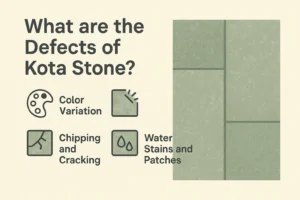What are the Defects of Kota Stone?
Kota stone is one of the most popular natural stones used for flooring and wall cladding in India. Known for its durability, natural beauty, and affordability, it is widely used in residential, commercial, and industrial projects. However, like all natural stones, Kota stone also has some limitations and defects that buyers should be aware of before making a purchase. Understanding these defects will help you select better quality stones and maintain them effectively.
Common Defects of Kota Stone
1. Color Variation
Kota stone is available mainly in greenish-blue and brownish tones.
Sometimes, the color may fade or appear uneven after polishing or long-term use.
Exposure to sunlight and water can also cause discoloration.
2. Surface Dullness
Unlike marble or granite, Kota stone does not naturally have a very shiny surface.
Even after mirror polishing, the shine may not last long and can become dull over time.
3. Chipping and Cracking
Thin Kota stone slabs are prone to chipping at the edges during handling and installation.
Cracks may also appear if the stone is not laid properly on a leveled base.
4. Water Stains and Patches
Kota stone is porous, which means it can absorb water and develop stains.
If water stagnates, white patches or salt deposits (efflorescence) may appear on the surface.
5. Uneven Thickness
Natural Kota stone is often hand-cut, which can lead to slight variations in thickness.
This may cause uneven flooring if not properly calibrated.
6. Limited Color Options
Unlike granite or marble, Kota stone is mainly available in limited shades of green and brown.
For homeowners looking for bright or varied colors, this may be seen as a drawback.
7. Not Suitable for All Climates
In very cold regions, Kota stone can become slippery when wet.
In highly humid areas, it may require frequent maintenance to avoid fungal growth.
How to Minimize Defects in Kota Stone?
Choose high-quality slabs from trusted suppliers.
Ensure proper thickness (at least 25–30 mm for flooring).
Apply sealants to reduce porosity and water absorption.
Do regular maintenance like cleaning and re-polishing to maintain shine.
Avoid acidic cleaners as they can damage the surface.
Conclusion
Kota stone is a strong, durable, and budget-friendly natural stone, but it does come with certain defects such as color variation, water stains, and surface dullness. By choosing good-quality material, ensuring proper installation, and doing regular maintenance, most of these issues can be minimized. Despite these drawbacks, Kota stone remains one of the most practical choices for flooring in India due to its strength, affordability, and natural charm.
FAQ — What are the Defects of Kota Stone? (with JSON-LD FAQPage schema)
FAQs (user-visible)
Q1: What are the most common defects of Kota stone?
A1: Common defects include color variation, surface dullness, chipping/cracks, water stains/efflorescence, uneven thickness and porosity-related problems.
Q2: Why does Kota stone show color variation?
A2: Color varies because Kota is a natural stone — mineral composition, quarry layer and finishing method cause differences in shade and tone.
Q3: How do water stains or white patches form on Kota stone?
A3: Kota stone is porous; water carrying dissolved salts can evaporate leaving salt deposits (efflorescence) or stains if moisture is trapped.
Q4: Can polishing fix all defects in Kota stone?
A4: Polishing improves surface appearance and reduces minor scratches, but it cannot correct structural issues like deep cracks, uneven thickness, or internal fissures.
Q5: How can I prevent chipping and cracking?
A5: Use thicker calibrated tiles, proper bedding mortar, an even sub-base, careful handling during transit/installation, and avoid point loads from heavy equipment.
Q6: Is sealing Kota stone effective?
A6: Yes — a good penetrating sealant reduces porosity, minimizes water stains and efflorescence, and makes cleaning easier. Reapply periodically per manufacturer instructions.
Q7: Is Kota stone suitable for bathrooms and outdoor use?
A7: It can be used, but choose textured finishes (not mirror polish) for wet areas to reduce slipperiness and ensure proper sealing and drainage outdoors.
Q8: How should I clean and maintain Kota stone?
A8: Clean with pH-neutral cleaners, avoid acidic products, dry spills quickly, reapply sealer as needed, and consider periodic honing or repolishing for high-traffic areas.
Q9: How do I identify good quality Kota stone?
A9: Good quality has uniform thickness, minimal visible cracks, even texture, consistent color range within a batch, and proper calibration from the supplier.

